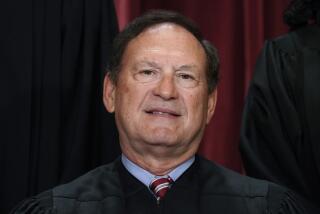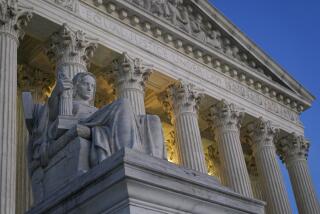Supreme Court appears poised to expand gun rights and restrict abortion in its new term

The Supreme Court is set to expand gun rights and restrict abortion rights in a new term that begins Monday, one that could reveal how fast and how far the conservative majority will move the law to the right.
“This term will reveal whether it is a far-right or center-right court,” said Aaron Tang, a UC Davis law professor and former clerk for Justice Sonia Sotomayor.
Guns, abortion and probably college affirmative action are before the court in the year ahead, all areas in which conservatives have been eager to recast the law. And with a 6-3 majority, the justices are poised to do just that.
For a decade, gun rights advocates have grumbled as the court refused to hear challenges to laws in California, New York and other blue states that restricted who could carry firearms in public or prohibited sales of some rapid-fire rifles and high-capacity magazines.
But President Trump’s three appointees — Justices Neil M. Gorsuch, Brett M. Kavanaugh and Amy Coney Barrett — believe the 2nd Amendment protects a right to be armed, and joined by Justices Clarence Thomas and Samuel A. Alito Jr., they can now strike down state laws that stand in the way.
They voted to hear a New York case that asks the court to rule that the Constitution protects the right to carry a loaded handgun when leaving home.
It “could signal the start of a new era of judicial hostility to gun control,” UCLA law professor Adam Winkler said. He said a ruling in favor of the New York gun owners could have big impact in Los Angeles County, where permits to carry a concealed weapon require a “special need” and are rarely granted.
A victory for the 2nd Amendment claim will “mean a lot more people carrying guns on the streets of cities like New York, Washington and Los Angeles,” he said. “Today there are only a few hundred people with concealed-carry permits” in Los Angeles, but after a ruling upholding a right to carry, “L.A. can expect to have about 500,000 people carrying firearms with a permit.” Arguments in New York State Rifle & Pistol Assn. vs. Bruen are set for Nov. 3.
The law on abortion may be transformed as well. In May, the justices voted to hear Mississippi’s defense of a law that would prohibit abortions after 15 weeks of a pregnancy. It was blocked by lower courts based on Roe vs. Wade, which legalized abortions up to about 24 weeks when a fetus is viable or capable of living on its own.
After winning review of the “viability” limit, the state’s lawyers expanded their argument and urged the court to overturn Roe entirely. It is “egregiously wrong,” they said in July, arguing the red states should be free to outlaw all abortions except those needed to save the mother’s life.
In years past, abortion rights advocates sounded the alarm when states like Texas and Louisiana adopted regulations that made it harder for abortion clinics to operate. Now, they face a threat of a different magnitude.
“This is an absolutely critical time for abortion rights,” said Jennifer Dalven, director of the ACLU’s Reproductive Freedom Project. Since Roe, “access to abortion has never been at risk like this before,” she said.
There appears to be little doubt Mississippi’s law will be upheld. What’s uncertain is whether the court’s conservatives will go further, allowing more limits on abortion or overturning the right entirely.
The court will hear arguments in the Mississippi case, Dobbs vs. Jackson Women’s Health Organization, on Dec. 1, and it may not issue a written ruling until June.
The justices could write an opinion that says Roe vs. Wade is overturned, leaving no doubt about the outcome. Or they could issue an opinion that forecasts what’s ahead. Much will turn on how the right to abortion is described.
“If they hold that pre-viability abortion bans should be reviewed for mere reasonableness or rationality, that is a very strong sign the court is far right,” Tang said. “If it is reasonable for the state to protect human life by banning abortions after 15 weeks, it’s hard to see why the same wouldn’t be true for banning abortions after six weeks.”
By contrast, he said, the court could affirm the principle that states may not put an “undue burden” on women seeking an abortion.
“On that more center-right approach, a ban like Mississippi’s could well be permissible because bans on abortions after 15 weeks arguably are not an undue burden,” because pregnant women would have time to consider an abortion. “But a six-week ban would be an undue burden since many women do not even know they are pregnant as of that point,” he said.
The outcome and the pace of change probably depends on Kavanaugh. He has described the abortion right as a “settled precedent” and sometimes joins Chief Justice John G. Roberts Jr. in favor of limited and moderately conservative rulings.
However, Gorsuch and Barrett, like Thomas and Alito, say respect for precedent is not enough to stand behind mistaken interpretations of the Constitution. And most conservatives have insisted the protections for “liberty” in the 14th Amendment of 1868 cannot be understood as protecting a right to abortion.
Last month, prospects dimmed for a moderately conservative retreat on abortion.
Confronted with a six-week ban on abortions set to go into effect, the court’s conservatives stood aside. By a 5-4 vote, they refused to block an unusual new Texas law that makes abortions illegal after about six weeks of a pregnancy and authorizes private lawsuits against doctors who perform such abortions and others.
Roberts said the court should have put the law on hold while judges weighed constitutional challenges to it. But none of his more conservative colleagues, including Kavanaugh, agreed to join him.
The Texas abortion ban remains in effect, leaving most pregnant women no option but to leave the state to seek an abortion. If Roe vs. Wade is overturned, at least a dozen Republican-led states in the South and Midwest are prepared to make nearly all abortions illegal.
College affirmative action is also before the court. In June, the justices looked over an appeal that asked the court to rule that colleges and universities may not weigh a student’s race or ethnicity in deciding who is admitted. In the case on appeal, a conservative group sued Harvard, contending that it systematically discriminates against Asian American applicants.
Rather than take up the case of Students for Fair Admissions vs. Harvard for the fall, the justices asked the Biden administration to weigh in on the issue. That may delay a decision on hearing the case until early next year, which could postpone a ruling until the next term.
At issue too is the high court’s public standing. Before the retirement of Justice Anthony M. Kennedy in 2018 and the death of Justice Ruth Bader Ginsburg last year, the court leaned right but was closely split on the most contentious issues. Most terms included several surprising outcomes.
But that appears less likely with six conservative Republican appointees and three liberal Democratic appointees. And the justices are very aware of the change in perception.
“My goal today is to convince you that this court is not comprised of a bunch of partisan hacks,” Barrett said last month.
She spoke days after the court divided along ideological lines and issued emergency orders that allowed the Texas abortion law to take effect, ended President Biden’s moratorium on evictions and upheld a Texas judge’s order reinstating Trump’s “Remain in Mexico” policy for asylum seekers.
Barrett’s intended message was not helped by the fact that she was speaking to a select audience in Louisville, Ky., at the invitation of Senate Republican leader Mitch McConnell, who used a narrow GOP majority to rush her nomination through the Senate days before the voters defeated Trump’s bid for reelection.
Justices Stephen G. Breyer and Thomas also spoke out in the last month to try to reassure listeners the court’s decisions are based on law and judicial philosophies, not politics. But several opinion polls reported a sharp drop in the court’s public standing since early summer.
“I think they may be deluding themselves,” said Georgetown law professor Irv Gornstein, who directs the Supreme Court Institute. If the court’s conservatives hand down sweeping victories for the right on abortion, guns, religion and affirmative action, “the perception of the court may be permanently altered.”
More to Read
Get the L.A. Times Politics newsletter
Deeply reported insights into legislation, politics and policy from Sacramento, Washington and beyond. In your inbox three times per week.
You may occasionally receive promotional content from the Los Angeles Times.







